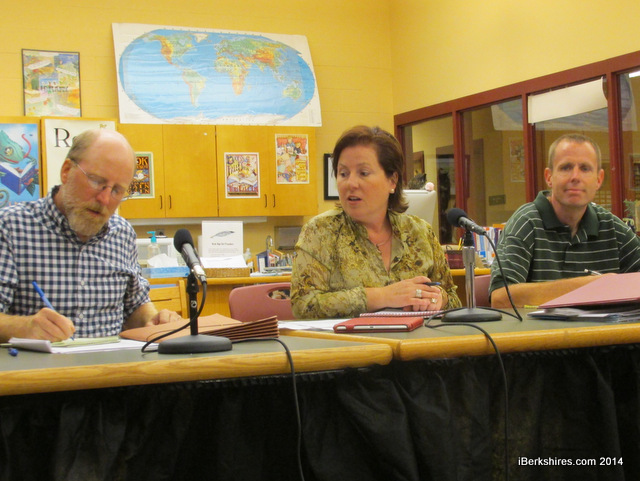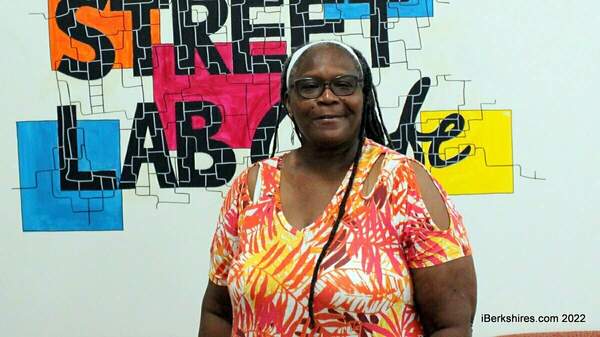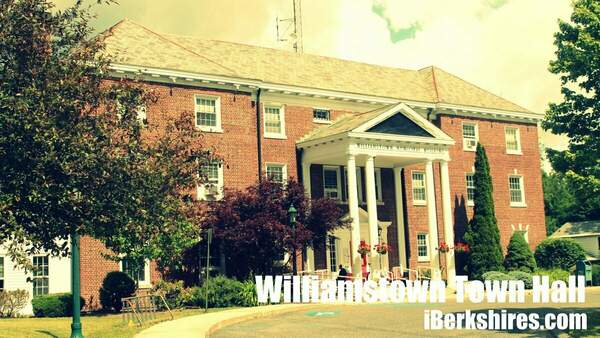Expanded Mount Greylock School District Questioned
 The School Committee listened to David Langston's arguments against joining the Mount Greylock Regional School District. The School Committee listened to David Langston's arguments against joining the Mount Greylock Regional School District. |
WILLIAMSTOWN, Mass. — The Williamstown Elementary School Committee on Wednesday heard the case for not moving the school into an expanded Mount Greylock Regional School District.
David Langston spoke to the panel about concerns he has with the way education is funded by Mount Greylock's other member town, Lanesborough.
"I've become more and more convinced that regionalization is not a particularly good idea for Williamstown," Langston said. "Regionalization for Williamstown Elementary means taking a school that's excellent and has good leadership and a distinguished record and enjoys reasonably good funding ... and placing it in a context where funding is a continuing series of losses that I think are not worth it."
Langston is a member of the Mount Greylock School Committee whose term is expiring and who is not seeking re-election in November. He took pains on Wednesday to clarify that he was addressing the WES Committee as a private citizen and not as a member of the regional school committee.
But it was clear from his remarks that his opinion was informed by his experience dealing with Lanesborough in the context of Mount Greylock's budget.
"Several years ago, we asked for a certain amount of money, and [Lanesborough town officials] claimed they couldn't meet it," Langston said. "We had to reduce their allocation by $50,000 because they claimed they had no money to cover it.
"When we got to town meeting, they had half a million dollars in their stabilization fund that was going unspent, and they were paying for things from the operating budget that should have come out of the stabilization fund."
Mount Greylock's operating budget is approved each spring in separate votes at Lanesborough's and Williamstown's annual town meetings. The two towns split the cost of the middle-high school budget based on a rolling five-year average of enrollment from each of the towns.
Although Lanesborough Elementary and Williamstown Elementary share a superintendency union (which in turn shares a superintendent with Mount Greylock), the two elementary schools are single-school districts. The PreK-6 schools' budgets in each town are a separate line item at each town's annual town meeting.
Mount Greylock's School Committtee has been moving in fits and starts toward asking Lanesborough and Williamstown voters to add the elementary schools to Mount Greylock and create a PreK-12 region. The Mount Greylock district in 2012 sought (and received) a
$50,000 state grant to study expanded regionalization.
A committee formed by the Mount Greylock committee
looked at the regionalization question for six months in 2013, but the district ultimately decided to put the issue on the backburner when the school was invited to enter the eligibility phase of the Massachusetts School Building Authority.
After Mount Greylock won votes at each member town's annual town meeting this spring to pay for the MSBA-ordered feasibility study, Mount Greylock officials decided to revisit the regionalization question and move toward putting the question before the voters.
Advocates of regionalization note that there are savings that could accrue from a more streamlined administration than the current "Tri-District" arrangement allows. They also point to incentives offered by the commonwealth for K-12 districts, including more support for transportation and higher reimbursement for a potential renovation or new building at Mount Greylock.
Langston alluded to those potential cost savings on Wednesday but said the cost of linking the elementary school's budget to the Lanesborough budget process could outweigh the benefit.
He mentioned that there were many Lanesborough residents who are committed to providing a quality education for the town's children, but he repeatedly questioned the commitment of Lanesborough's town leadership.
"The town leadership in Lanesborough has not had public education as something they were willing to make sacrifices for," Langston said.
"Consistently, the town leadership has wanted to solve any budgetary problems by negotiating things so they stayed under the levy limit. They have never wanted to go to the question of an override vote."
Langston said when Massachusetts passed Proposition 2 1/2 in 1980, the debate at that time indicated that Prop 2 1/2 overrides would be common.
 Langston, a Mount Greylock committee member who said he was speaking as a citizen, is concerned that Williamstown's students would be at the mercy of Lanesborough's budgetary woes if it regionalized. Langston, a Mount Greylock committee member who said he was speaking as a citizen, is concerned that Williamstown's students would be at the mercy of Lanesborough's budgetary woes if it regionalized. |
"To avoid an override vote over a period of time runs counter to the spirit of Proposition 2 1/2," Langston said. "To impoverish the education system [without putting the question to the voters] is something I don't have very much patience with."
Langston said there may be the potential to rework the Mount Greylock Regional Agreement to create different funding mechanisms for an expanded districts. But without such modifications, he said he could not support adding Williamstown to the Mount Greylock district.
He said he planned to make the same case to the Board of Selectmen and town manager.
The three members of the School Committee — who heard similar thoughts from Langston at a recent joint meeting of the Williamstown and Mount Greylock committees — listened to his presentation without comment.
In other business on Wednesday, the School Committee heard a report from the Tri-District's Director of Pupil Personnel Services Kimberley Grady on the school's staffing special education students. She said the 22 current staff in special education are adequate to serve a slightly higher student population in those programs.
Superintendent Rose Ellis told the committee the elementary school's total population also is growing.
Last year on Oct. 1, the school had 439 pupils. As of Monday, it has 458, an increase of little more than 4 percent. The number is a little higher even than the 445 the school anticipated in the spring due to new families moving into the district.
The average class size is 17.6 with the largest classes (21.7 per classroom) in the sixth grade. The largest single grade remains the third grade, which has 69 pupils divided into four sections (17.3 pupils per classroom.
"You can see that the class sizes are comfortable," Ellis told the committee, referring to the school's enrollment data. "I can remember 26 or 27 [pupils] in the sixth grade a few years ago."
Tags: MGRHS, regionalization, WES,
 The School Committee listened to David Langston's arguments against joining the Mount Greylock Regional School District.
The School Committee listened to David Langston's arguments against joining the Mount Greylock Regional School District.  Langston, a Mount Greylock committee member who said he was speaking as a citizen, is concerned that Williamstown's students would be at the mercy of Lanesborough's budgetary woes if it regionalized.
Langston, a Mount Greylock committee member who said he was speaking as a citizen, is concerned that Williamstown's students would be at the mercy of Lanesborough's budgetary woes if it regionalized.














